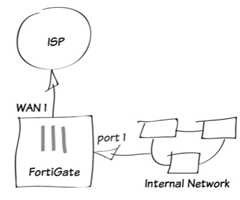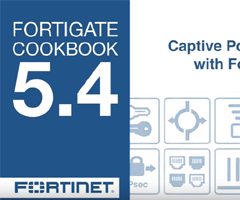Custom FortiClient Installations
The FortiClient Configurator tool FortiClient is the recommended method of creating customized FortiClient installation files.
You can also customize which modules are displayed in the FortiClient dashboard in the FortiClient Profile. This will allow you to activate any of the modules at a later date without needing to re-install FortiClient. Any changes made to the FortiClient Profile are pushed to registered clients.
When creating VPN only installation files, you cannot enable other modules in the FortiClient Profile as only the VPN module is installed.
When deploying a custom FortiClient XML configuration, use the advanced FortiClient Profile options in FortiGate to ensure the FortiClient Profile settings do not overwrite your custom XML settings. For more information, see the FortiClient XML Reference and the CLI Reference forFortiOS.
The FortiClient Configurator tool is included with the FortiClient Tools file in FortiClient 5.2. This file is only available on the Customer Service & Support portal and is located in the same file directory as the FortiClient images.
The Configurator tool requires activation with a license file. Ensure that you have completed the following steps prior to logging in to your FortiCare product web portal:
- Purchased FortiClient Registration License l Activated the FortiClient license on a FortiGate
This video explains how to purchase and apply a FortiClient License: http://www.youtube.com/watch?feature=player_embedded&v=sIkWaUXK0Ok This chapter contains the following sections:
- Download the license file l Create a custom installer l Custom installation packages l Advanced FortiClient profiles
Download the license file
To retrieve your license file:
- Go to https://support.fortinet.com and log in to your FortiCare account.
- Under Asset select Manage/View Products. Select the FortiGate device that has the FortiClient registration license activated. You will see the Get the Key File link in the Available Key(s)
- Click the link and download license file to your management computer. This file will be needed each time you use the FortiClient Configurator tool.
Create a custom installer
Fortinet offers a repacking tool for both Microsoft Windows and Mac OS X operating systems. The following section provides instructions on creating a custom installer file using the FortiClient Configurator tool.
When selecting to install custom features, only modules selected are installed. To enable other features you will need to uninstall FortiClient, and reinstall an MSI file with these features included in the installer.
FortiClient (Windows) Configurator tool
To create a custom installer using the FortiClient Configurator tool:
- Unzip the FortiClientTools file, select the FortiClientConfigurator file folder, and double-click the exe application file to launch the tool.
The tool opens at the Welcome page.
| Licensed |
Licensed mode requires a FortiClient license file. |
| Trial |
In FortiClient 5.4, the FortiClient Configurator tool can be used in trial mode. In trial mode, all online updates are disabled. The trial installer is intended to be deployed in a test environment. |
- Browse and select the FortiClient Configurator Activation Key file (.lic) on your management computer.
- After entering the FortiClient Configurator license, select Next. The Configuration File page is displayed.
| Select Config File (optional) |
The configuration file (.conf, .sconf) settings will be included in the installer file. |
| Password |
If the configuration file is encrypted (.sconf), enter the password used to encrypt the file. |
You can use an XML editor to make changes to the FortiClient configuration file. For more information on FortiClient XML configuration, see the FortiClient XML Reference in the Fortinet Document Library, http://docs.fortinet.com.
- Browse and select the FortiClient configuration file on your management computer. This is an optional step. If you do not want to import settings from a configuration file, select Skip to continue. The Settings page is displayed.
The following options are available for custom installations:
| Features to Install |
|
| Everything |
All Security and VPN components will be installed. |
| Client security only |
Only AntiVirus, Web Filtering, and Application Firewall will be installed. |
| VPN only |
Only VPN components (IPsec and SSL) will be installed. |
| Other |
Select one of the following from the drop-down list:
l AntiVirus & Web Filtering only l Web Filtering only l Application Firewall only l Application Firewall & Web Filtering only l Web Filtering, VPN and Application Firewall l Single Sign-On mobility agent only |
| Options |
|
| Desktop Shortcut |
Select to create a FortiClient desktop icon. |
| Start Menu |
Select to add FortiClient to the start menu. |
| Enable Software Update |
Select to enable software updates. This option is disabled when Rebrand
FortiClient is selected. This option is also disabled when using Trial mode. |
| Configure Single Sign-On mobility agent |
Select to configure Singe Sign-On mobility agent for use with FortiAuthenticator. |
| Features to Install |
|
| Rebrand
FortiClient |
Select to rebrand FortiClient. When selected, the option to enable software update is not available. For more information on rebranding FortiClient, see Appendix C – Rebranding FortiClient on page 137. |
- Select the features to install and options and select Next to continue.
If you selected to configure the single sign-on mobility agent, the Single Sign-On Mobility Agent Settings page is displayed.
- Configure the following settings:
| Server IP/FQDN |
Enter the IP address or FQDN of the FortiAuthenticator server. |
| Port Number |
Enter the port number. The default port is 8001. |
| Pre-Shared Key |
Enter the FortiAuthenticator pre-shared key. |
| Confirm Pre-Shared Key |
Enter the FortiAuthenticator pre-shared key confirmation. |
- Select Next to continue. If you selected to rebrand FortiClient, the Rebranding page is displayed.
- Rebrand FortiClient elements as required. The resources folder contains graphical elements. For more information, see Appendix C – Rebranding FortiClient on page 137.
- Select Next to continue. The Package Signing page is displayed.
- Configure the following settings:
| Select Code Signing Certificate (optional) |
If you have a code signing certificate, you can use it to digitally sign the installer package this tool generates. |
| Password |
If the certificate file is password protected, enter the password. |
- Browse and select the code signing certificate on your management computer. This is an optional step. If you do not want to digitally sign the installer package, select Skip to continue. The Execution page is displayed.
This page provides details of the installer file creation and the location of files for Active Directory deployment and manual distribution. The tool creates files for both 32-bit (x86) and 64-bit (x64) operating systems.
- When you select Finish, if Browse to output MSI file upon exit is selected, the folder containing the newly created MSI file will open.
Before deploying the custom MSI files, it is recommended that you test the packages to confirm that they install correctly. In FortiClient 5.2.0 and later, an .exe installation file is created for manual distribution.
Installation files are organized in folders within the FortiClientTools > FortiClient Configurator > FortiClient repackaged folder. Folder names identify the type of installation files that were created and the creation date.
FortiClient (Mac OS X) Configurator tool
To create a custom installer using the FortiClient Configurator tool:
- Unzip the FortiClientTools file, select the Configurator file folder, and double-click the
FortiClientConfigurator.dmg application file, and double-click the FCTConfigurator icon to launch the tool. The Configurator tool opens.
- Configure the following settings:
| Licensed | Trial |
Licensed mode requires a FortiClient 5.2 license file. In FortiClient v5.2, the FortiClient Configurator tool can be used in trial mode. In trial mode, all online updates are disabled. The trial installer is intended to be deployed in a test environment. |
| Source |
Select the FortiClient Installer file on your management computer. You must use the full installer file, otherwise FortiClient Configurator will fail to create a custom installation file.
The FortiClient Installer version and FortiClient Configurator version must match, otherwise the Configurator will fail to create a custom installation file. |
| Destination |
Enter a name for the custom installation file and select a destination to save the file on your management computer. |
| Features to Install |
Select to install all FortiClient modules, VPN only, or SSO only. If SSO only is selected, you must configure the SSO settings in the attached configuration file. |
| Server IP/FQDN |
Enter the IP address or FQDN of the FortiAuthenticator server.
This option is available when selecting SSO only for features to install. |
| Port Number |
Enter the port number. The default port is 8001.
This option is available when selecting SSO only for features to install. |
| Pre-Shared Key |
Enter the FortiAuthenticator pre-shared key.
This option is available when selecting SSO only for features to install. |
| Confirm Pre-Shared Key |
Enter the FortiAuthenticator pre-shared key confirmation.
This option is available when selecting SSO only for features to install. |
Custom installation packages
| Config file |
Optionally, select a pre-configured FortiClient backup configuration file. If you selected Everything or VPN only for features to install, you must use a configuration file to configure the related settings. |
| Software Update |
Select to enable or disable software updates. |
| Rebrand |
Select to rebrand FortiClient. When selected, the option to enable software update is not available. For more information on rebranding FortiClient, see Appendix C – Rebranding FortiClient on page 137. |
| Rebranding resources |
Select the FortiClient resources file on your management computer. |
- Select the Start button to create the custom FortiClient installation file.
- You can now deploy the repackaged FortiClient .dmg file to your Mac OS X systems.
Custom installation packages
When deploying a custom FortiClient XML configuration, use the advanced FortiClient Profile options in FortiGate to ensure the FortiClient Profile settings do not overwrite your custom XML settings. For more information, see the FortiClient XML Reference and the CLI Reference forFortiOS.
Advanced FortiClient profiles
FortiClient (Windows)
After the configurator tool generates the custom installation packages, it can be used to deploy the FortiClient software either manually, or using Active Directory. Both options can be found in the …/FortiClient_packaged directory. Files are created for both x86 (32-bit) and x64 (64-bit) operating systems.
If Active Directory is being used to deploy FortiClient, you can use the custom installer with the MST file found in the …/ActiveDirectory folder.
For manual distribution, use the .exe file in the …/ManualDistribution folder.
Advanced FortiClient profiles
When creating custom FortiClient MSI files for deployment, you will need to configure advanced FortiClient profiles on the FortiGate/EMS to ensure that settings in the FortiClient profile do not overwrite your custom XML settings. You can configure the FortiClient profile to deliver the full XML configuration, VPN only, or specific FortiClient XML configurations. For more information on customizing the FortiClient XML configuration file, see the Appendix C – Rebranding FortiClient on page 137.
Fortinet recommends creating OS specific endpoint profiles when provisioning XML settings. When creating a new FortiClient profile, select the device group as either Windows PC or Mac. If a FortiClient (Windows) XML configuration is pushed to a FortiClient (Mac OS X) system, FortiClient (Mac OS X) will ignore settings which are not supported.
Provision a full XML configuration file
You can deploy the full XML configuration file from the CLI or GUI.
To deploy the full XML configuration via the CLI:
- Log in to the FortiGate Command-line Interface.
- Enter the following CLI commands: config endpoint-control profile edit <profile_name>
config forticlient-winmac-settings set forticlient-advanced-cfg enable
set forticlient-advanced-cfg-buffer “Copy & Paste your FortiClient XML configuration here”
Advanced FortiClient profiles
Copy directly from your XML editor, preserving the XML file format. Copy all information from the <?xml version=”1.0″ encoding=”UTF-8″ ?> start of syntax to the </forticlient_configuration> end of syntax XML tags. Add double quotes at the start and end of the XML syntax statements.
To deploy the full XML configuration via the FortiGate GUI:
- Go to Security Profiles > FortiClient Profiles.
- Select the FortiClient Profile and select Edit from the toolbar. The Edit FortiClient Profile page is displayed.
- Configure the following settings:
| Profile Name |
Enter a unique name to identify the FortiClient profile. |
| Comments |
Optionally, enter a comment. |
| Assign Profile To |
For more information on configuring device groups, user groups, and users, see the FortiOS Handbook.
These options are only available when creating a new FortiClient profile. You can assign the profile to user groups and users when using Active Directory authentication or RADIUS authentication for VPN.
FortiClient does not support nested groups in FortiOS. |
| XML text window |
Copy and paste the FortiClient XML configuration file in the text window. The XML syntax must be preserved. |
- Select Apply to save the FortiClient profile settings.
To deploy the full XML configuration via EMS:
- Go to Endpoint Profiles and either select a profile to edit, or create a new profile.
- Select the Advanced option to the right of the profile name.
- Select Yes in the confirmation dialog box.
- Copy and paste the XML configuration file text into the text box.
- Select Save to save the FortiClient profile settings.
Partial configuration
The current buffer size is 32kB. This may not be large enough to accommodate your FortiClient XML configuration. As a workaround, you can use the FortiClient Configurator tool to create a custom MSI installation file using a .confFortiClient backup configuration that contains static custom configurations. You can then include a partial configuration in the advanced FortiClient profile. This will push the partial configuration when the client registers with the FortiGate. The partial configuration will be merged with the existing XML configuration on the client.
To provision specific FortiClient XML configuration while preserving custom XML configurations in your MSI file, cut & paste the specific XML configuration into the FortiClient Profile in the following format:
<?xml version=”1.0″ encoding=”UTF-8″ ?>
Advanced FortiClient profiles
<forticlient_configuration>
<partial_configuration>1</partial_configuration>
<system>
<ui>
<ads>0</ads>
<default_tab>VPN</default_tab>
<flashing_system_tray_icon>0</flashing_system_tray_icon>
<hide_system_tray_icon>0</hide_system_tray_icon>
<suppress_admin_prompt>0</suppress_admin_prompt>
<culture_code>os-default</culture_code>
</ui>
<update>
<use_custom_server>0</use_custom_server>
<port>80</port>
<timeout>60</timeout>
<failoverport>8000</failoverport>
<fail_over_to_fdn>1</fail_over_to_fdn>
<scheduled_update>
<enabled>0</enabled>
<type>interval</type>
<daily_at>03:00</daily_at>
<update_interval_in_hours>3</update_interval_in_hours>
</scheduled_update>
</update>
</system>
</forticlient_configuration>
Ensure that the <partial_configuration>1</partial_configuration> tag is set to 1 to indicate that this partial configuration will be deployed upon registration with the FortiGate. All other XML configuration will be preserved.
Advanced VPN provisioning
You need to enable VPN provisioning and advanced VPN from the FortiOS CLI to import the FortiClient XML VPN configuration syntax. You can import the XML VPN configuration in the CLI or the GUI.
Import XML VPN configuration into the FortiClient Profile via the CLI:
- Log in to your FortiGate command-line interface.
- Enter the following CLI commands: config endpoint-control profile edit <profile_name>
config forticlient-winmac-settings set forticlient-vpn-provisioning enable set forticlient-advanced-vpn enable set auto-vpn-when-off-net enable set auto-vpn-name <VPN name to connect to automatically when off-net> set forticlient-advanced-vpn-buffer <Copy & paste the advanced VPN configuration>
end
end
After the forticlient-vpn-provisioning and forticlient-advancedvpn CLI commands are enabled, the forticlient-advanced-vpn-buffer CLI command is available from the CLI.
Advanced FortiClient profiles
Copy directly from your XML editor, preserving the XML file format. Copy all information from the <vpn> start of syntax to the </vpn> end of syntax XML tags. Add double quotes before the <vpn> tag and after the </vpn> tag.
- You can also choose to copy & paste the XML content in the GUI, go to Security Profiles > FortiClient Profiles and select the VPN
- Configure the following settings:
| Profile Name |
Enter a unique name to identify the FortiClient profile. |
| Comments |
Optionally, enter a comment. |
| Assign Profile To |
For more information on configuring device groups, user groups, and users, see the FortiOS Handbook.
These options are only available when creating a new endpoint profile. You can assign the profile to user groups and users when using Active Directory authentication or RADIUS authentication for VPN.
FortiClient does not support nested groups in FortiOS. |
| VPN |
Enable Client VPN Provisioning.
Cut and paste the FortiClient XML configuration <vpn> to </vpn> tags in the text window. The XML syntax must be preserved.
Enable Auto-connect when Off-Net and select a VPN name from the dropdown list. |
- Select Apply to save the FortiClient profile settings.
For more information, see Appendix A – Deployment Scenarios on page 127.



